With so much focus on the Vatican at the moment, this seems a good time to take a spin through the world of Pope related books. But with so many to choose from, and of greatly varying quality, where to start? To help sift the wheat from the chaff, I turned to our Facebook friends (yes, I know technically they're fans but I prefer to think of them as friends), and posted the following question:
"I'm looking for books to recommend about the Papacy - both fiction and nonfiction. If you know of a "best in class" book about Popes past or present, or about the Vatican/Catholic Church in general, please do post. Thank you!"
Below are some of their recommendations:
History & Biography
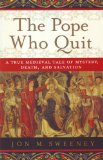 The Pope Who Quit by Jon M Sweeney: A True Medieval Tale of Mystery, Death, and Salvation by Jon M. Sweeney
The Pope Who Quit by Jon M Sweeney: A True Medieval Tale of Mystery, Death, and Salvation by Jon M. Sweeney (2012)
With seemingly prescient timing, Sweeney's biography tells the life story, as far as is known, of Pope Celestine V who reigned for six months in 1294 and was the only Pope to abdicate the papacy until Pope Benedict. The future Pope Celestine was born Pietro of Morrone, a hermit who founded the monastic order of the Hermits of St Damiano, later known as the Celestines. Apparently, he made the tactical error of sending a letter of
apocalyptic foreboding to the College of Cardinals who had failed to elect a Pope for two years. Unfortunately, for Pietro, the dean of the College of Cardinals was so inspired by his letter that he nominated him as the next pope. Six months later, having not even reached Rome, Pope Celestine V abdicated.
Read an excerpt on the publisher's website
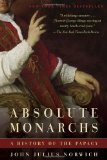 Absolute Monarchs: A History of the Papacy by John Julius Norwich
Absolute Monarchs: A History of the Papacy by John Julius Norwich (2011)
British historian Norwich has written and presented about 30 TV documentaries and is the author of a number of history books covering a diverse range of topics from Byzantium to Norman Sicily. In 2011 he published
Absolute Monarchs which, in the introduction, he describes as "a straightforward single-volume history" of the world's "most astonishing social, political, and spiritual institution ever created." According to the reviewer for the LA Times, Norwich lives up to his claim with a history book that is mostly free of opinion and commentary written in an "unstuffy and sometimes witty writing style".
Read an excerpt on the publisher's website
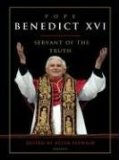 Pope Benedict XVI - Servant of the Truth by Peter Seewald
Pope Benedict XVI - Servant of the Truth by Peter Seewald (2006)
The book jacket blurb for this "lavishly illustrated" coffee-table book asks: Do you know the real Pope Benedict? Journalist Peter Seewald does. After writing an unfair attack on Cardinal Ratzinger, he was urged by Catholic readers to meet with the man he was maligning. He did so - and the result was two book-length interviews,
Salt of the Earth and
God and the World. Seewald also returned to his Catholic faith, saying that Ratzinger was the one who "taught me what it meant to swim against the stream." This book, written mainly by Seewald, describes the paths of Joseph Ratzinger's life from his birthplace in Bavaria all the way to being the first German Pope in 482 years."
Look inside the book at Amazon
Those who enjoy this book might be interested in the two books that the former Cardinal Ratzinger wrote while Pope:
The God of Jesus Christ: Meditations on the Triune God and Jesus of Nazareth: From the Baptism in the Jordan to the Transfiguration.
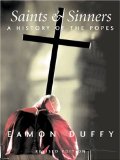 Saints and Sinners: A History of the Popes by Eamon Duffy
Saints and Sinners: A History of the Popes by Eamon Duffy (first published in 1997, 3rd edition published 2006)
An all encompassing history of the papacy from its beginnings nearly 2000 years ago. The third edition includes an extended final chapter covering the last years of Pope John Paul II and the election of Benedict XVI. Although created as a tie-in to a six-part British television series on the history of the papacy, Kirkus Reviews opines that the "history is surprisingly dense and sophisticated." While Duffy certainly doesn't steer clear of the salacious aspects of the papacy over the centuries, he uses the evolving institution of the papacy to view two millennia of Western civilization.
View a large, albeit poorly scanned, sample at Google Books
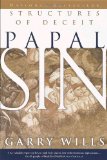 Papal Sin by Garry Wills
Papal Sin by Garry Wills (2000)
Pulitzer Prize-winning author Garry Wills offers a stinging critique of the Catholic Church and its hierarchy from the nineteenth century to five years before the death of John Paul II. Wills, a lifetime Catholic, is proficient in Greek and Latin, has degrees in Philosophy and a PhD in Classics and has been on the faculty of Northwestern University since 1980, where he is currently an Emeritus Professor of History. As Publishers Weekly says, "though his rhetoric is at times a bit sharp, and his historical formulae a bit too sweeping, Wills's passion is excusable since this is a philippic directed at the Church by one its own."
Read an excerpt at BookBrowse
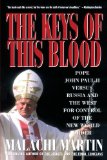 The Keys of This Blood: Pope John Paul II Versus Russia and the West for Control of the New World Order by Malachi Martin
The Keys of This Blood: Pope John Paul II Versus Russia and the West for Control of the New World Order by Malachi Martin (1990)
Malachai Martin (1921-1999) was an Irish Catholic priest. Originally ordained as a Jesuit priest, he became Professor of Palaeontology at the Vatican's Pontifical Biblical Institute, and from 1958 also served as a theological adviser to Cardinal Augustin Bea during preparations for the Second Vatican Council. Disillusioned by reforms he renounced his vows in 1964 and moved to New York. He wrote 17 books, both fiction and nonfiction, that were frequently critical of the Catholic Church.
The Keys of This Blood written just after the fall of the Berlin Wall, argues that Pope John Paul II was a geopolitican playing a "millennium end-game" against Mikhail Gorbachev and international business leaders, with the aim of establishing a new world order. As we're now more than a decade into the new millenium, this book is arguably a little dated, but a number of recent reviews on GoodReads indicate that it's still being read and recommended.
Look inside the book at Amazon
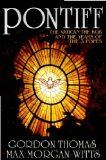 Pontiff by Gordon Thomas and Max Morgan-Witts
Pontiff by Gordon Thomas and Max Morgan-Witts (1983)
No roundup of Papal books would be complete without
Pontiff, co-authored by my father-in-law, Max Morgan-Witts. Published in 1983 after over two years of extensive research, the book focuses on the period from 1978 (the year which saw the death of Pope Paul VI, the election and death 33 days later of John Paul 1, and the election of John Paul II) through to the assassination attempt of 1981, in which John Paul II survived four bullet wounds. A blockbuster in the mid-1980s in a number of countries including the USA,
Pontiff was the book that opened my eyes to the joys of nonfiction at the formative age of 20, when I realized that narrative nonfiction did not equate with dry and dull but, in fact, offered the best of both worlds, a form that could have the page-turning appeal of a novel combined with the relevance of fact. Thanks Max!
View a sample at Google Books
Fiction
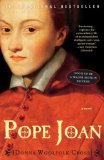 Pope Joan by Donna Woolfolk Cross
Pope Joan by Donna Woolfolk Cross (1996)
By far the most recommended Pope related book was this perennial book club favorite.
Pope Joan tells the story of the brilliant and talented Joan who, in a medieval society that forbade women from learning to read or write, took her dead brother's place as an initiate at the monastery and rose to become Pope. According to an
interview with the author, while the Catholic Church says that Pope Joan was an invention of Protestant reformers eager to expose papist corruption, there are over 500 contemporary manuscripts referencing Joan, and in 1276, after ordering a thorough search of the papal records, Pope John XX changed his title to John XXI in official recognition of Joan's reign as Pope John VIII.
Browse an excerpt on BookBrowse
 White Smoke by Andrew M Greeley
White Smoke by Andrew M Greeley (1996)
White Smoke explores the pomp, circumstance and intrigue that accompanies the election of a new Pope in the near future. Kirkus Reviews describes it as "diverting, albeit message-laden". Chicago native and Catholic priest, Andrew Greeley is a professor of social science at the University of Chicago and the University of Arizona, as well as Research Associate at the National Opinion Research Center at the University of Chicago. His current sociological research focuses on issues facing the Catholic Church-including celibacy of priests, ordination of women, religious imagination, and sexual behavior of Catholics. Father Greeley's bibliography includes more than 30 novels, numerous articles on sociology, religion and education (including a syndicated newspaper column) and an autobiography,
Furthermore! Confessions of a Parish Priest.
Read an excerpt on the publisher's website
 Shoes of the Fisherman by Morris West
Shoes of the Fisherman by Morris West (1963)
Morris Langlo West (1916-1999) was an Australian novelist and playwright best known for his novels
The Devil's Advocate (1959),
The Shoes of the Fisherman (1963) and
The Clowns of God (1981). West's books tend to focus on international politics and the role of the Roman Catholic Chuch in the political arena.
The Shoes of the Fisherman describes the election and career of a Slavic Pope, a Russian cardinal who is also the youngest in the conclave. This was 15 years before the election of the relatively young Pole Karol Wojtyla as Pope John Paul II.
The sequel,
The Clowns of God describes a successor Pope, who resigns the papacy to live in seclusion.
Lazarus (1990), the final volume in West's Vatican trilogy, portrays a modern pontiff presiding in a time of terrorism and violence. The 1968 film based on
Shoes of the Fisherman won best film at the National Board review and was nominated for a Golden Globe and Oscar.
Read an excerpt on the publisher's website
More Recommendations
Here are some recommendations related to the Catholic Church but not strictly about the Papacy:
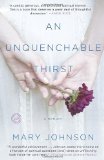 An Unquenchable Thirst by Mary Johnson
An Unquenchable Thirst by Mary Johnson (Biography, 2011)
At seventeen, Mary Johnson saw Mother Teresa's face on the cover of
Time and experienced her calling. Eighteen months later, she entered a convent in the South Bronx to begin her religious training. Not without difficulty, this bright, independent-minded Texas teenager eventually adapted to the sisters' austere life of poverty and devotion, and in time became close to Mother Teresa herself. Still, beneath the white and blue sari beat the heart of an ordinary young woman facing the struggles we all share - the desire for love and connection, meaning and identity. During her twenty years with the Missionaries of Charity, Sister Donata, as she was known, grappled with her faith, her sexuality, the politics of the order, and her complicated relationship with Mother Teresa. Eventually, she left the church to find her own path - one that led to love and herself.
Read an excerpt on the publisher's website
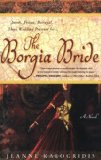 The Borgia Bride by Jeanne Kalogridis
The Borgia Bride by Jeanne Kalogridis (2005)
Against the backdrop of 15th-century Italian internecine feuds, debauchery and Vatican corruption, Kalogridis spins a tale of royal power plays and passions. Sancha de Aragon, illegitimate daughter of the duke of Calabria, is married to Jofre, the youngest son of the House of Borgia, in order to strengthen ties between the two families. Hearing of his daughter-in-law's great beauty it's not long before Pope Aleander VI recalls Jofre to Rome. There Sancha must side-step the Pope's lecherous advances; placate the dangerous and jealous Lucrezia, her sister-in-law; while somehow keeping her steamy love affair with her Cardinal brother-in-law in check.
Look inside the book at Amazon
 The Name of the Rose by Umberto Eco
The Name of the Rose by Umberto Eco (1980 in Italian, 1983 in English)
The year is 1327. Franciscans in a wealthy Italian abbey are suspected of heresy, and Brother William of Baskerville arrives to investigate.When his delicate mission is suddenly overshadowed by seven bizarre deaths, Brother William turns detective. He collects evidence, deciphers secret symbols and coded manuscripts, and digs into the eerie labyrinth of the abbey where extraordinary things are happening under the cover of night.
View at sample at Google Books
 Earthly Powers by Anthony Burgess
Earthly Powers by Anthony Burgess (1980)
Anthony Burgess's epic follows the lives of two men who each represent different kinds of earthly power. Kenneth Toomey is an eminent novelist, a man who has outlived his contemporaries to survive into luxurious old age as a celebrity of dubious notoriety. Don Carlo Campanati is a man of God, who rises through the Vatican as a subtle negotiator and shrewd manipulator to become the controversial architect of church revolution and a candidate for sainthood.
Look inside the book at Amazon
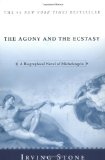 The Agony and the Ecstasy: A Biographical Novel of Michelangelo by Irving Stone
The Agony and the Ecstasy: A Biographical Novel of Michelangelo by Irving Stone (1961)
A powerful and passionate biographical novel of Michelangelo. Michelangelo Buonarotti, creator of "David", painter of the Sistine ceiling, architect of the dome of St Peter's, lives once more in Irving Stone's marvelous book.
Look inside the book at Amazon
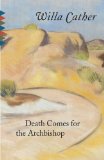 Death Comes for the Archbishop by Willa Cather
Death Comes for the Archbishop by Willa Cather (1927)
When Cather first visited the American Southwest in 1912, she found a new world to imagine and soon came to feel that "the story of the Catholic Church in [the Southwest] was the most interesting of all its stories." The narrative follows Bishop Jean Latour and Father Joseph Vaillant, friends since their childhood in France, as they organize the new Roman Catholic diocese of Santa Fe subsequent to the Mexican War. While seeking to revive the church and build a cathedral in the desert, the clerics, like their historical prototypes, Bishop Jean Lamy and Father Joseph Machebeuf, face religious corruption, natural adversity, and the loneliness of living in a strange and unforgiving land. Included in Time Magazine's 100 Best English-language novels from 1923-2005.
Read instantly at B&N
And finally, a quick etymological detour:
Catholic translates literally as "universally accepted", which traces its routes to the Latin catholicus and the Greek katholikos. The earliest recorded use of the term Catholic Church is in a letter by Ignatius of Antioch to Christians in Smyrna written in about 107 AD.
Pope derives from the Greek papas, meaning "father." Initially the term was applied to senior priests of the Western part of the church, but by the 6th century it was mainly used to describe the Bishop of Rome and in the 11th century, a couple of decades after the great schism between the Eastern and Western churches, Pope Gregory VII declared its use soley for himself, the Bishop of Rome. The heads of the Coptic Orthodox Church of Alexandria and Greek Orthodox Church of Alexandria are also referred to as Pope.
Pontiff comes from the Latin pontifex, but Greek scholars, in antiquity and today, seem somewhat divided over the derivation of pontifex. Some say it derives from pons (bridge) and facere (to make) - which possibly traces to ancient religious rites associated with bridges, or perhaps should be understood in the more symbolic sense - that the pontifices were the bridge between gods and men. Others, including Plutarch, believed pontifex derived from the Old Latin potis, meaning a powerful or absolute master.
A number of other etymological theories exist, but what is sure is that the Collegium Pontificum (College of Pontiffs) was the most important priesthood of ancient Rome led by the Pontifex Maximus. The College of Pontiffs (all male, except for the Vestal Virgins) was in charge of the fifteen official cults of Roman religion.
Later, pontiff was applied to Christian bishops. As such, while the term "pontiff" is now most often used in relation to the Pope, technically speaking it can refer to any bishop. Thus "Roman Pontiff" means literally "Bishop of Rome", but a Pontifical Mass is a form of high mass celebrated by a bishop. Although Pontifex Maximus is not among the Pope's official titles, it does appear in inscriptions, both ancient and modern, referring to the Pope.
by Davina Morgan-Witts
 The Pope Who Quit by Jon M Sweeney: A True Medieval Tale of Mystery, Death, and Salvation by Jon M. Sweeney (2012)
The Pope Who Quit by Jon M Sweeney: A True Medieval Tale of Mystery, Death, and Salvation by Jon M. Sweeney (2012) Absolute Monarchs: A History of the Papacy by John Julius Norwich (2011)
Absolute Monarchs: A History of the Papacy by John Julius Norwich (2011) Pope Benedict XVI - Servant of the Truth by Peter Seewald (2006)
Pope Benedict XVI - Servant of the Truth by Peter Seewald (2006) Saints and Sinners: A History of the Popes by Eamon Duffy
Saints and Sinners: A History of the Popes by Eamon Duffy  Papal Sin by Garry Wills (2000)
Papal Sin by Garry Wills (2000) The Keys of This Blood: Pope John Paul II Versus Russia and the West for Control of the New World Order by Malachi Martin (1990)
The Keys of This Blood: Pope John Paul II Versus Russia and the West for Control of the New World Order by Malachi Martin (1990) Pontiff by Gordon Thomas and Max Morgan-Witts (1983)
Pontiff by Gordon Thomas and Max Morgan-Witts (1983) Pope Joan by Donna Woolfolk Cross (1996)
Pope Joan by Donna Woolfolk Cross (1996)
 White Smoke by Andrew M Greeley (1996)
White Smoke by Andrew M Greeley (1996) Shoes of the Fisherman by Morris West (1963)
Shoes of the Fisherman by Morris West (1963) An Unquenchable Thirst by Mary Johnson (Biography, 2011)
An Unquenchable Thirst by Mary Johnson (Biography, 2011) The Borgia Bride by Jeanne Kalogridis (2005)
The Borgia Bride by Jeanne Kalogridis (2005) The Name of the Rose by Umberto Eco (1980 in Italian, 1983 in English)
The Name of the Rose by Umberto Eco (1980 in Italian, 1983 in English) Earthly Powers by Anthony Burgess (1980)
Earthly Powers by Anthony Burgess (1980) The Agony and the Ecstasy: A Biographical Novel of Michelangelo by Irving Stone (1961)
The Agony and the Ecstasy: A Biographical Novel of Michelangelo by Irving Stone (1961) Death Comes for the Archbishop by Willa Cather (1927)
Death Comes for the Archbishop by Willa Cather (1927)